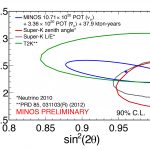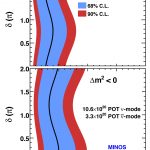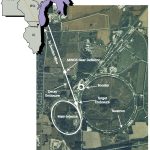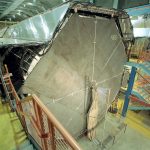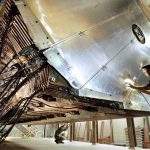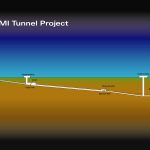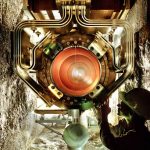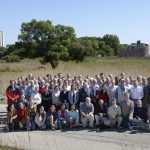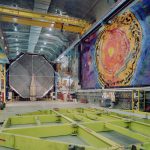Batavia, Illinois—Scientists from the MINOS experiment at the Department of Energy’s Fermi National Accelerator Laboratory have revealed the world’s most precise measurement of a key parameter that governs the transformation of one type of neutrino to another. The results confirm that neutrinos and their antimatter counterparts, antineutrinos, have similar masses as predicted by most commonly accepted theories that explain how the subatomic world works.
MINOS caused a jolt in the physics world in 2010 when it announced that a measurement of this parameter, called delta m squared, showed a surprisingly large difference between the masses of neutrinos and antineutrinos. A subsequent 2011 measurement with increased statistics appeared to bring the neutrino and antineutrino masses closer in sync. With twice as much antineutrino data collected since its 2011 result, scientists confirm that the gap has closed. This upholds predictions and provides crucial information for many other neutrino experiments around the globe.
The new measurement is one of several announced this week by the MINOS experiment at the Neutrino 2012 conference in Kyoto, Japan. These are the final results from the first phase of the MINOS experiment.
“At the end of its initial seven-year run, MINOS has proven that it has been an incredibly successful long-baseline neutrino experiment,” said Fermilab’s Rob Plunkett, MINOS co-spokesperson. “We look forward to the next phase, when we will search for a new type of neutrino.”
MINOS scientists also announced this week their latest measurement of the search for a rare phenomenon, the transformation of muon neutrinos into electron neutrinos. The Daya Bay experiment in China and the RENO experiment in Korea made headlines earlier this year with their measurements of this transformation, observed in neutrinos generated by nuclear reactors.
To measure the transformation of one type of neutrino to another, the MINOS experiment sends a beam of muon neutrinos 450 miles (735 kilometers) through the earth from the Main Injector accelerator at Fermilab to a 5,000-ton neutrino detector located half a mile underground in the Soudan Underground Laboratory in northern Minnesota. The experiment uses two almost identical detectors: the detector at Fermilab is used to check the purity of the muon neutrino beam, and the detector at Soudan looks for electron and muon neutrinos. The neutrinos’ trip from Fermilab to Soudan takes about 2.5 milliseconds, giving the neutrinos enough time to change their identities.
With its full data set collected, MINOS recorded a total of 21 electron-neutrino-like events on top of a background of 79. This represents 40% more data than its 2011 measurement of this transformation. The larger data set allowed MINOS scientists to improve their measurement of a parameter that describes this transformation, called sin22θ13. The new measurement remains consistent with the experiment’s previous measurements and provides an important clue to understanding the puzzle of neutrinos – how they transform from one type to another, and which of the three neutrino types is the most massive.
Because MINOS uses different types of neutrinos than those produced by nuclear reactors, and compared to the Japanese experiment T2K has its two detectors significantly farther apart, its measurements of the transformation of muon to electron neutrinos are sensitive to different effects than other worldwide experiments. In particular, depending on how nature has chosen to order the neutrino masses, MINOS measurements of the parameter sin22θ13 could be different from those made by T2K.
“The results from MINOS have pushed the endeavor into the next phase: now we start to look for the mass ordering of neutrinos,” said University College London Professor Jenny Thomas, co-spokesperson for the MINOS experiment. “Fermilab will lead this endeavor with its NOvA experiment that will start next year.”
In 2013 the upgraded Fermilab accelerator complex will send an even more intense and higher-energy beam of muon neutrinos to two experiments in Northern Minnesota: the brand-new NOvA experiment and the second phase of MINOS. In its next phase, MINOS will focus on the hunt for a fourth type of neutrino. Hints of a fourth type have been observed in two previous experiments.
The MINOS experiment involves more than 140 scientists, engineers, technical specialists and students from 30 institutions, including universities and national laboratories, in five countries: Brazil, Greece, Poland, the United Kingdom and the United States. Funding comes from: the U.S. Department of Energy’s Office of Science; the U.K.’s Science and Technology Facilities Council; the U.S. National Science Foundation; the University of Minnesota, which operates the Soudan Underground Laboratory; Brazil’s Foundation for Research Support of the State of São Paulo (FAPESP) and National Council of Scientific and Technological Development (CNPq) and the University of Athens in Greece.
Fermilab is America’s premier national laboratory for particle physics research. A U.S. Department of Energy Office of Science laboratory, Fermilab is located near Chicago, Illinois and operated under contract by the Fermi Research Alliance, LLC. Visit Fermilab’s website at http://www.fnal.gov and follow us on Twitter at @FermilabToday.
The DOE Office of Science is the single largest supporter of basic research in the physical sciences in the United States, and is working to address some of the most pressing challenges of our time. For more information, please visit http://science.energy.gov.
- This graph shows the parameters for muon neutrino mixing. The blue curve shows the latest MINOS result for the boundary of the region of allowed values for the mixing parameters. The MINOS result is compared with measurements from other experiments (red, gray, green).The blue star is the set of parameters preferred by the MINOS data, specifically a delta m squared of 2.39×10-3 ev2 and a value for sin2 (2theta) of 0.96. The new MINOS result uses all neutrino beam and antineutrino beam data from the NuMI beamline and also includes data from atmospheric neutrinos collected at the MINOS detector.
- The blue and red regions in both plots show the areas allowed by MINOS for the parameters of electron-neutrino appearance. The top plot shows the MINOS measurement for one ordering of neutrino masses; the bottom plot shows the same measurement assuming the other mass ordering. The vertical axis shows allowed values of an unknown parameter that controls how much neutrinos and antineutrinos show different behavior in this process.
- Scientists know that there exist three types of neutrinos and three types of antineutrinos. Cosmological observations and laboratory-based experiments indicate that the masses of these particles must be extremely small: Each neutrino and antineutrino must weigh less than a millionth of the weight of an electron.
- Neutrinos, ghost-like particles that rarely interact with matter, travel 450 miles straight through the earth from Fermilab to Soudan — no tunnel needed. The Main Injector Neutrino Oscillation Search (MINOS) experiment studies the neutrino beam using two detectors. The MINOS near detector, located at Fermilab, records the composition of the neutrino beam as it leaves the Fermilab site. The MINOS far detector, located in Minnesota, half a mile underground, again analyzes the neutrino beam. This allows scientists to directly study the oscillation of muon neutrinos into electron neutrinos or tau neutrinos under laboratory conditions.
- The MINOS far detector is located in a cavern half a mile underground in the Soudan Underground Laboratory, Minnesota. The 100-foot-long MINOS far detector consists of 486 massive octagonal planes, lined up like the slices of a loaf of bread. Each plane consists of a sheet of steel about 25 feet high and one inch thick, with the last one visible in the photo. The whole detector weighs 6,000 tons. Since March 2005, the far detector has recorded neutrinos from a beam produced at Fermilab. The MINOS collaboration records about 1,000 neutrinos per year.
- The 1,000-ton MINOS near detector sits 350 feet underground at Fermilab. The detector consists of 282 octagonal-shaped detector planes, each weighing more than a pickup truck. Scientists use the near detector to verify the intensity and purity of the muon neutrino beam leaving the Fermilab site. Photo: Peter Ginter
- Fermilab completed the construction and testing of the Neutrino at the Main Injector (NuMI) beam line in early 2005. Protons from Fermilab’s Main Injector accelerator (left) travel 1,000 feet down the beam line, smash into a graphite target and create muon neutrinos. The neutrinos traverse the MINOS near detector, located at the far end of the NuMI complex, and travel straight through the earth to a former iron mine in Soudan, Minnesota, where they cross the MINOS far detector. Some of the neutrinos arrive as electron neutrinos or tau neutrinos.
- When operating at highest intensity, the NuMI beam line transports a package of 35,000 billion protons every two seconds to a graphite target. The target converts the protons into bursts of particles with exotic names such as kaons and pions. Like a beam of light emerging from a flashlight, the particles form a wide cone when leaving the target. A set of two special lenses, called horns (photo), is the key instrument to focus the beam and send it in the right direction. The beam particles decay and produce muon neutrinos, which travel in the same direction. Photo: Peter Ginter
- More than 140 scientists, engineers, technical specialists and students from Brazil, Greece, Poland, the United Kingdom and the United States are involved in the MINOS experiment. This photo shows some of them posing for a group photo at Fermilab, with the 16-story Wilson Hall and the spiral-shaped MINOS service building in the background.
- Far view The University of Minnesota Foundation commissioned a mural for the MINOS cavern at the Soudan Underground Laboratory, painted onto the rock wall, 59 feet wide by 25 feet high. The mural contains images of scientists such as Enrico Fermi and Wolfgang Pauli, Wilson Hall at Fermilab, George Shultz, a key figure in the history of Minnesota mining, and some surprises. A description of the mural, painted by Minneapolis artist Joe Giannetti, is available here.

